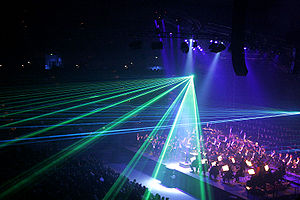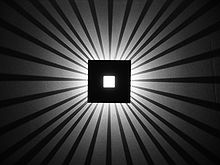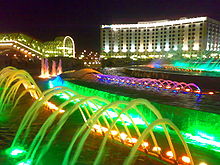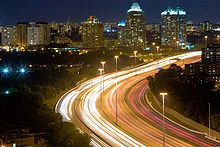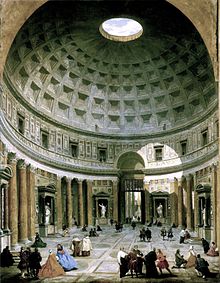- Lighting
-
Not to be confused with lightning.For other uses, see lighting (disambiguation).
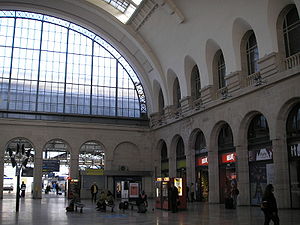 Daylight used at the train station Gare de l'Est Paris
Daylight used at the train station Gare de l'Est Paris
Lighting or illumination is the deliberate application of light to achieve some practical or aesthetic effect. Lighting includes the use of both artificial light sources such as lamps and light fixtures, as well as natural illumination by capturing daylight. Daylighting (using windows, skylights, or light shelves) is often used as the main source of light during daytime in buildings. This can save energy compared with artificial lighting, which represents a major component of energy consumption in buildings. Without proper design, energy can be wasted by using too much light, or using out-dated technology. Proper lighting can enhance task performance, improve the appearance of an area, and have positive psychological effects on occupants. One of the central dogmas of proper lighting is that a uniform illumination is required in many applications, such as projection displays, LCD backlights, medical lighting, microscopy, solid-state lighting, and general lighting. [1]
Indoor lighting is usually accomplished using light fixtures, and is a key part of interior design. Lighting can also be an intrinsic component of landscape projects.
Contents
Fixtures
Main article: Light fixtureLighting fixtures come in a wide variety of styles for various functions. The most important functions are as a holder for the light source, to provide directed light and to avoid visual glare. Some are very plain and functional, while some are pieces of art in themselves. Nearly any material can be used, so long as it can tolerate the excess heat and is in keeping with safety codes.
An important property of light fixtures is the luminous efficacy or wall-plug efficiency, meaning the amount of usable light emanating from the fixture per used energy, usually measured in lumen per watt. A fixture using replaceable light sources can also have its efficiency quoted as the percentage of light passed from the "bulb" to the surroundings. The more transparent the lighting fixture is, the higher efficacy. Shading the light will normally decrease efficacy but increase the directionality and the visual comfort probability.
Color temperature for white light sources also affects their use for certain applications. The color temperature of a white light source is the temperature in Kelvin of a theoretical black body emitter that most closely matches the spectral characteristics of the lamp. An incandescent bulb has a color temperature around 2800 to 3000 Kelvin; daylight is around 6400 Kelvin. Lower color temperature lamps have relatively more energy in the yellow and red part of the visible spectrum, while high color temperatures correspond to lamps with more of a blue-white appearance. For critical inspection or color matching tasks, or for retail displays of food and clothing, the color temperature of the lamps will be selected for the best overall lighting effect.
Types
Lighting is classified by intended use as general, accent, or task lighting, depending largely on the distribution of the light produced by the fixture.
- Task lighting is mainly functional and is usually the most concentrated, for purposes such as reading or inspection of materials. For example, reading poor-quality reproductions may require task lighting levels up to 1500 lux (150 footcandles), and some inspection tasks or surgical procedures require even higher levels.
- Accent lighting is mainly decorative, intended to highlight pictures, plants, or other elements of interior design or landscaping.
- General lighting (sometimes referred to as ambient light) fills in between the two and is intended for general illumination of an area. Indoors, this would be a basic lamp on a table or floor, or a fixture on the ceiling. Outdoors, general lighting for a parking lot may be as low as 10-20 lux (1-2 footcandles) since pedestrians and motorists already used to the dark will need little light for crossing the area.
Methods
- Downlighting is most common, with fixtures on or recessed in the ceiling casting light downward. This tends to be the most used method, used in both offices and homes. Although it is easy to design it has dramatic problems with glare and excess energy consumption due to large number of fittings.[2]
- Uplighting is less common, often used to bounce indirect light off the ceiling and back down. It is commonly used in lighting applications that require minimal glare and uniform general illuminance levels. Uplighting (indirect) uses a diffuse surface to reflect light in a space and can minimize disabling glare on computer displays and other dark glossy surfaces. It gives a more uniform presentation of the light output in operation. However indirect lighting is completely reliant upon the reflectance value of the surface. While indirect lighting can create a diffused and shadow free light effect it can be regarded as an uneconomical lighting principle.[3][4]
- Front lighting is also quite common, but tends to make the subject look flat as its casts almost no visible shadows. Lighting from the side is the less common, as it tends to produce glare near eye level. Backlighting either around or through an object is mainly for accent.
Forms of lighting
Indoor lighting
Forms of lighting include alcove lighting, which like most other uplighting is indirect. This is often done with fluorescent lighting (first available at the 1939 World's Fair) or rope light, or occasionally with neon lighting. It is a form of backlighting.
Soffit or close to wall lighting can be general or a decorative wall-wash, sometimes used to bring out texture (like stucco or plaster) on a wall, though this may also show its defects as well. The effect depends heavily on the exact type of lighting source used.
Recessed lighting (often called "pot lights" in Canada, "can lights" or 'high hats" in the US) is popular, with fixtures mounted into the ceiling structure so as to appear flush with it. These downlights can use narrow beam spotlights, or wider-angle floodlights, both of which are bulbs having their own reflectors. There are also downlights with internal reflectors designed to accept common 'A' lamps (light bulbs) which are generally less costly than reflector lamps. Downlights can be incandescent, fluorescent, HID (high intensity discharge) or LED.
Track lighting, invented by Lightolier, was popular at one point because it was much easier to install than recessed lighting, and individual fixtures are decorative and can be easily aimed at a wall. It has regained some popularity recently in low-voltage tracks, which often look nothing like their predecessors because they do not have the safety issues that line-voltage systems have, and are therefore less bulky and more ornamental in themselves. A master transformer feeds all of the fixtures on the track or rod with 12 or 24 volts, instead of each light fixture having its own line-to-low voltage transformer. There are traditional spots and floods, as well as other small hanging fixtures. A modified version of this is cable lighting, where lights are hung from or clipped to bare metal cables under tension.
A sconce is a wall-mounted fixture, particularly one that shines up and sometimes down as well. A torchiere is an uplight intended for ambient lighting. It is typically a floor lamp but may be wall-mounted like a sconce.
The portable or table lamp is probably the most common fixture, found in many homes and offices. The standard lamp and shade that sits on a table is general lighting, while the desk lamp is considered task lighting. Magnifier lamps are also task lighting.
The illuminated ceiling was once popular in the 1960s and 1970s but fell out of favor after the 1980s. This uses diffuser panels hung like a suspended ceiling below fluorescent lights, and is considered general lighting. Other forms include neon, which is not usually intended to illuminate anything else, but to actually be an artwork in itself. This would probably fall under accent lighting, though in a dark nightclub it could be considered general lighting.
In a movie theater each step in the aisles is usually marked with a row of small lights, for convenience and safety when the film has started, hence the other lights are off. Traditionally made up of small low wattage, low voltage lamps in a track or translucent tube, these are rapidly being replaced with LED based versions.
Outdoor lighting
Street Lights are used to light roadways and walkways at night. Some manufacturers are designing LED and photovoltaic luminaires to provide an energy-efficient alternative to traditional street light fixtures.[5][6][7]
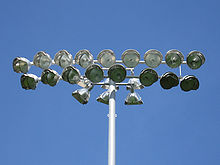 Floodlights are used to illuminate outdoor playing fields or work zones during nighttime.
Floodlights are used to illuminate outdoor playing fields or work zones during nighttime.
Floodlights can be used to illuminate outdoor playing fields or work zones during nighttime hours. The most common type of floodlights are metal halide and high pressure sodium lights.
Beacon lights are positioned at the intersection of two roads to aid in navigation.
Security lights can be used along roadways in urban areas, or behind homes or commercial facilities. These are extremely bright lights used to deter crime. Security lights may include floodlights.
Entry lights can be used outside to illuminate and signal the entrance to a property.[8] These lights are installed for safety, security, and for decoration.
Underwater accent lighting is also used for koi ponds, fountains, swimming pools and the like.
Vehicle use
Main article: Automotive lightingVehicles typically include headlamps and tail lights. Headlamps are white or selective yellow lights placed in the front of the vehicle, designed to illuminate the upcoming road and to make the vehicle more visible. Many manufactures are turning to LED headlights as an energy-efficient alternative to traditional headlamps.[9] Tail and brake lights are red and emit light to the rear so as to reveal the vehicle's direction of travel to following drivers. White rear-facing reversing lamps indicate that the vehicle's transmission has been placed in the reverse gear, warning anyone behind the vehicle that it is moving backwards, or about to do so. Flashing turn signals on the front, side, and rear of the vehicle indicate an intended change of position or direction.
In addition to lighting for useful purposes, manufacturers would sometimes backlight their logos and or other translucent paneling in the 1970s. In the 1990s, a popular trend was to customize vehicles with neon lighting, especially underneath the body of a car. In the 2000s, neon lighting is increasingly yielding to digital vehicle lighting, in which bright LEDs are placed on the car and operated by a computer which can be customized and programmed to display a range of changing patterns and colors, a technology borrowed from Christmas lights.
Lamps
Main article: Lamp (electrical component)Commonly called 'light bulbs', lamps are the removable and replaceable part of a light fixture, which converts electrical energy into electromagnetic radiation. While lamps are often rated in terms of how much power they use in watts, the power does not necessarily correspond to the amount of light produced. For example, a 60 W incandescent light bulb produces about the same amount of light as a 13 W compact fluorescent lamp. Each of these technologies has a different efficacy in converting electrical energy to visible light. Visible light output is typically measured in lumens. This unit only quantifies the visible radiation, and excludes invisible infrared and ultraviolet light. A wax candle produces on the close order of 13 lumens, a 60 watt incandescent lamp makes around 700 lumens and a 15-watt compact fluorescent lamp produces about 800 lumens, but actual output varies due to specific design. [10] Comparison of the lumen output of different types of lamp, instead of the electrical power input, gives a better basis for comparison of light produced.
It is important to be able to differentiate types of lamps and lamp technologies. These include:- Ballast: A ballast is an auxiliary piece of equipment designed to start and properly control the flow of power to discharge light sources such as fluorescent and high intensity discharge (HID) lamps. Some lamps require the ballast to have thermal protection.
- fluorescent light: A long straight tube coated with phosphor containing low pressure mercury vapor that produces white light.
- Halogen: High pressure incandescent lamps containing halogen gases such as iodine or bromine, allowing filaments to be operated at higher temperatures.
- Neon: A low pressure gas contained within a glass tube; the color emitted depends on the gas.
- Light emitting diodes: Light emitting diodes (LED) are solid state lamps without the filaments that would burn out on ordinary light bulbs. LEDs emit light produced from the movement of electrons in a semiconductor material.[11]
- Compact fluorescent lamps: CFLs are designed to replace incandescent lamps in existing and new installations.[12][13]
Design and architecture
Architectural lighting design
Main article: Architectural lighting designLighting design as it applies to the built environment, also known as 'architectural lighting design', is both a science and an art. Lighting of structures must consider aesthetic elements as well as practical considerations of quantity of light required, occupants of the structure, energy efficiency and cost. The amount of daylight received in an internal space can be analized by undertaking a Daylight factor calculation. For simple installations, hand-calculations based on tabular data can be used to provide an acceptable lighting design. More critical or optimized designs now routinely use mathematical modeling on a computer using software such as Radiance which can allow an Architect to quickly undertake complex calculations to review the benefit of a particular design.
In some design instances, materials used on walls and furniture play a key role in the lighting effect. Dark paint tends to absorb light, making the room appear smaller and more dim than it is, whereas light paint does the opposite. In addition to paint, reflective surfaces also have an effect on lighting design. Surfaces or floors that are too reflective create unwanted glare.[4][15]
Photometric studies
Photometric studies (also sometimes referred to as "layouts" or "point by points") are often used to simulate lighting designs for projects before they are built or renovated. This enables architects, lighting designers, and engineers to determine whether a proposed lighting setup will deliverer the amount of light intended. In many cases these studies are referenced against IESNA recommended lighting practices for the type of application. Depending on the type of area, different design aspects may be emphasized by IESNA for safety or practicality (i.e. such as maintaining uniform light levels or highlighting certain areas). Specialized software is often used to create these, which typically combine the use of two-dimensional CAD software drawings and lighting simulation software (i.e. AGi32).
Performance lighting
Main article: Stage lightingIn addition to letting the audience see the performers, the lighting of a live theatre,dance, or concert stage has the objective of creating dramatic effects. Stage lighting uses all the technologies of general illumination, but stage lighting instruments emphasize easy adjustment of the characteristics of emitted light. The set-up of stage lighting not only varies from one production to another, but lighting will change during each scene of the performance. Dimmers, colored filters, reflectors, lenses, motorized or manually-aimed lamps, and different kinds of flood and spot lights are the tools used by a stage lighting designer to produce the desired effects. A set of lighting cues are prepared so that the lighting operator can control the lights in step with the performance; complex theatre lighting systems use computer control of lighting instruments.
Motion picture and television production use many of the same tools and methods of stage lighting. Especially in the early days of these industries, very high light levels were required and heat produced by lighting equipment was a significant problem to lighting designers. Modern cameras are more sensitive, but the use of artificial and available natural light sources must still be carefully designed.
Measurement
Main article: Photometry (optics)Measurement of light or photometry is generally concerned with the amount of useful light falling on a surface and the amount of light emerging from a lamp or other source, along with the colors that can be rendered by this light. The human eye responds differently to light from different parts of the visible spectrum, therefore photometric measurements must take the luminosity function into account when measuring the amount of useful light. The basic SI unit of measurment is the candela (cd), which describes the luminous intensity, all other photometric units are derived from the candela. Luminance for instance is a measure of the density of luminous intensity in a given direction. It describes the amount of light that passes through or is emitted from a particular area, and falls within a given solid angle. The SI unit for luminance is candela per square metre (cd/m2). The CGS unit of luminance is the stilb, which is equal to one candela per square centimetre or 10 kcd/m2. The amount of useful light emitted from a source or the luminous flux is measured in lumen (lm).
The SI unit of illuminance and luminous emittance, being the luminous power per area, is measured in Lux. It is used in photometry as a measure of the intensity, as perceived by the human eye, of light that hits or passes through a surface. It is analogous to the radiometric unit watts per square metre, but with the power at each wavelength weighted according to the luminosity function, a standardized model of human visual brightness perception. In English, "lux" is used in both singular and plural.[16]
Several measurement methods have been developed to control glare resulting from indoor lighting design. The Unified Glare Rating (UGR) athe Visual Comfort Probability, and the Daylight Glare Index are some of the most well-known methods of measurement. In addition to these new methods, four main factors influence the degree of discomfort glare; the luminance of the glare source, the solid angle of the glare source, the background luminance, and the position of the glare source in the field of view must all be taken into account.[3][17]
Color properties
To define light source color properties, the lighting industry predominantly relies on two metrics, correlated color temperature (CCT), commonly used as an indication of the apparent “warmth” or “coolness” of the light emitted by a source, and color rendering index (CRI), an indication of the light source’s ability to make objects appear natural.
However, these two metrics, developed in the last century, are facing increased challenges and criticisms as new types of light sources, particularly light emitting diodes (LEDs), become more prevalent in the market.
For example, in order to meet the expectations for good color rendering in retail applications, research[18] suggests using the well-established CRI along with another metric called gamut area index (GAI). GAI represents the relative separation of object colors illuminated by a light source; the greater the GAI, the greater the apparent saturation or vividness of the object colors. As a result, light sources which balance both CRI and GAI are generally preferred over ones that have only high CRI or only high GAI.[19]
Light exposure
Typical measurements of light have used a Dosimeter. Dosimeters measure an individual's or an object's exposure to something in the environment, such as light dosimeters and ultraviolet dosimeters.
In order to specifically measure the amount of light entering the eye, personal circadian light meter called the Daysimeter has been developed.[20] This is the first device created to accurately measure and characterize light (intensity, spectrum, timing, and duration) entering the eye that affects the human body's clock.
The small, head-mounted device measures an individual's daily rest and activity patterns, as well as exposure to short-wavelength light that stimulates the circadian system. The device measures activity and light together at regular time intervals and electronically stores and logs its operating temperature. The Daysimeter can gather data for up to 30 days for analysis.[21]
Energy consumption
Artificial lighting consumes a significant part of all electrical energy consumed worldwide. In homes and offices from 20 to 50 percent of total energy consumed is due to lighting.[22] Most importantly, for some buildings over 90 percent of lighting energy consumed can be an unnecessary expense through over-illumination.[22] The cost of that lighting can be substantial. A single 100 W light bulb used just 6 hours a day can cost over $25 per year to use (.12/kWh). Thus lighting represents a critical component of energy use today, especially in large office buildings where there are many alternatives for energy usage in lighting. There are several strategies available to minimize energy requirements in any building:
- Specification of illumination requirements for each given use area.
- Analysis of lighting quality to ensure that adverse components of lighting (for example, glare or incorrect color spectrum) are not biasing the design.
- Integration of space planning and interior architecture (including choice of interior surfaces and room geometries) to lighting design.
- Design of time of day use that does not expend unnecessary energy.
- Selection of fixture and lamp types that reflect best available technology for energy conservation.
- Training of building occupants to use lighting equipment in most efficient manner.
- Maintenance of lighting systems to minimize energy wastage.
- Use of natural light - some big box stores are being built (ca 2006 on) with numerous plastic bubble skylights, in many cases completely obviating the need for interior artificial lighting for many hours of the day.
- Load shedding can help reduce the power requested by individuals to the main power supply. Load shedding can be done on an individual level, at a building level, or even at a regional level.
Specification of illumination requirements is the basic concept of deciding how much illumination is required for a given task. Clearly, much less light is required to illuminate a hallway or bathroom compared to that needed for a word processing work station. Generally speaking, the energy expended is proportional to the design illumination level. For example, a lighting level of 80 footcandles might be chosen for a work environment involving meeting rooms and conferences, whereas a level of 40 footcandles could be selected for building hallways. If the hallway standard simply emulates the conference room needs, then twice the amount of energy will be consumed as is needed for hallways. Unfortunately, most of the lighting standards even today have been specified by industrial groups who manufacture and sell lighting, so that a historical commercial bias exists in designing most building lighting, especially for office and industrial settings.
Automated lighting control
Building automation and lighting control solutions are now available to help reduce energy usage and cost by eliminating over-illumination. These solutions provide centralized control of all lighting within a home or commercial building, allowing easy implementation of scheduling, occupancy control, daylight harvesting and more. Many systems also support Demand response and will automatically dim or turn off lights to take advantage of DR incentives and cost savings.
Many newer control systems are using wireless mesh open standards (such as ZigBee), which provides benefits including easier installation (no need to run control wires) and interoperability with other standards-based building control systems (e.g. security).[23]
In response to daylighting technology, daylight-linked automated response systems have been developed to further reduce energy consumption. These technologies are helpful, but they do have their downfalls. Many times, rapid and frequent switching of the lights on and off can occur, particularly during unstable weather conditions or when daylight levels are changing around the switching illuminance. Not only does this distrub occupants, it can also reduce lamp life. A variation of this technology is the 'differential switching or dead-band' photoelectric control which has multiple illuminances it switches from so as not to disturb occupants as much.[2][24]
Occupancy sensors to allow operation for whenever someone is within the area being scanned can control lighting. When motion can no longer be detected, the lights shut off. Passive infrared sensors react to changes in heat, such as the pattern created by a moving person. The control must have an unobstructed view of the building area being scanned. Doors, partitions, stairways, etc. will block motion detection and reduce its effectiveness. The best applications for passive infrared occupancy sensors are open spaces with a clear view of the area being scanned. Ultrasonic sensors transmit sound above the range of human hearing and monitor the time it takes for the sound waves to return. A break in the pattern caused by any motion in the area triggers the control. Ultrasonic sensors can see around obstructions and are best for areas with cabinets and shelving, restrooms, and open areas requiring 360-degree coverage. Some occupancy sensors utilize both passive infrared and ultrasonic technology, but are usually more expensive. They can be used to control one lamp, one fixture or many fixtures.[25][26]
Daylighting
Main article: DaylightingDaylighting is the oldest method of interior lighting. Daylighting is simply designing a space to use as much natural light as possible. This decreases energy consumption and costs, and requires less heating and cooling from the building. Daylighting has also been proven to have positive effects on patients in hospitals as well as work and school performance. Due to a lack of information that indicate the likely energy savings, daylighting schemes are not yet popular among most buildings.[2][27]
Health effects
It is valuable to provide the correct light intensity and color spectrum for each task or environment. Otherwise, energy not only could be wasted but over-illumination can lead to adverse health and psychological effects.
Beyond the energy factors being considered, it is important not to over-design illumination, lest adverse health effects such as headache frequency, stress, and increased blood pressure be induced by the higher lighting levels. In addition, glare or excess light can decrease worker efficiency.[28]
Analysis of lighting quality particularly emphasizes use of natural lighting, but also considers spectral content if artificial light is to be used. Not only will greater reliance on natural light reduce energy consumption, but will favorably impact human health and performance. New studies have shown that the performance of students is influenced by the time and duration of daylight in their regular schedules. Designing school facilities to incorporate the right types of light at the right time of day for the right duration may improve student performance and well-being. Similarly, designing lighting systems that maximize the right amount of light at the appropriate time of day for the elderly may help relieve symptoms of Alzheimer's Disease. The human circadian system is entrained to a 24-hour light-dark pattern that mimics the earth’s natural light/dark pattern. When those patterns are disrupted, they disrupt the natural circadian cycle. Circadian disruption may lead to numerous health problems including breast cancer, seasonal affective disorder, delayed sleep phase syndrome, and other ailments.[29][30]
A study conducted in 1972 and 1981, documented by Robert Ulrich, surveyed 23 surgical patients assigned to rooms looking out on a natural scene. The study concluded that patients assigned to rooms with windows allowing lots of natural light had shorter postoperative hospital stays, received fewer negative evaluative comments in nurses’ notes, and took fewer potent analegesics than 23 matched patients in similar rooms with windows facing a brick wall. This study suggests that due to the nature of the scenery and daylight exposure was indeed healthier for patients as opposed to those exposed to little light from the brick wall. In addition to increased work performance, proper usage of windows and daylighting crosses the boundaries between pure aesthetics and overall health.[31][27]
Environmental issues
Kerosene and whale-oil lamps
In 1849, Dr. Abraham Gesner, a Canadian geologist, devised a method where kerosene could be distilled from petroleum. Earlier coal-gas methods had been used for lighting since the 1820s, but they were expensive. Gesner's kerosene was cheap, easy to produce, could be burned in existing lamps, and did not produce an offensive odor as did most whale oil. It could be stored indefinitely, unlike whale oil, which would eventually spoil. The American petroleum boom began in the 1850s. By the end of the decade there were 30 kerosene plants operating in the United States. The cheaper, more efficient fuel began to drive whale oil out of the market. John D. Rockefeller was most responsible for the commercial success of kerosene. He set up a network of kerosene distilleries which would later become Standard Oil, thus completely abolishing the need for whale-oil lamps.[32]
Compact fluorescent lamps
Compact fluorescent lamps (aka 'CFLs') use less power to supply the same amount of light as an incandescent lamp. Due to the ability to reduce electric consumption, many organizations have undertaken measures to encourage the adoption of CFLs. Some electric utilities and local governments have subsidized CFLs or provided them free to customers as a means of reducing electric demand. For a given light output, CFLs use between one fifth and one quarter of the power of an equivalent incandescent lamp. One of the simplest and quickest ways for a household or business to become more energy efficient is to adopt CFLs as the main lamp source, as suggested by the Alliance for Climate Protection
LED lamps
LED lamps have been advocated as the newest and best environmental lighting method.[33] According to the Energy Saving Trust, LED lamps use only 10% power compared to a standard incandescent bulb, where compact fluorescent lamps use 20% and energy saving halogen lamps 70%. A downside is still the initial cost, which is higher than that of compact fluorescent lamps. General Electric expects to begin producing organic LEDs for architectural use by 2010.[34]
Light pollution
Light pollution is a growing problem in reaction to excess light being given off by numerous signs, houses, and buildings. Polluting light is often wasted light involving unnecessary energy costs and carbon dioxide emissions. Light pollution is describing as artificial light that is excessive or intrudes where it is not wanted. Well-designed lighting sends light only where it is needed without scattering it elsewhere. Poorly designed lighting can also compromise safety. For example, glare creates safety issues around buildings by causing very sharp shadows, temporarily blinding passersby making them vulnerable to would-be assailants.[35][36]
Military use
From a military standpoint, lighting is a critical part of the battlefield conditions.[37] Shadows are good places to hide, while bright areas are more exposed. It is often beneficial to fight with the Sun or other light source behind you, giving your enemy disturbing visual glare and partially hiding your own movements in backlight. If natural light is not present searchlights and flares can be used. However the use of light may disclose your own hidden position and modern warfare have seen increased use of night vision through the use of infrared cameras and image intensifiers.
Flares can also be used by the military to mark positions, usually for targeting, but laser-guided and GPS weapons have eliminated this need for the most part.
Professional organizations
International
The International Commission on Illumination (CIE) is an international authority and standard defining organization on color and lighting. Publishing widely used standard metrics such as various CIE color spaces and the color rendering index.
The Illuminating Engineering Society of North America (IESNA), in conjunction with organizations like ANSI and ASHRAE, publishes guidelines, standards, and handbooks that allow categorization of the illumination needs of different built environments. Manufacturers of lighting equipment publish photometric data for their products, which defines the distribution of light released by a specific luminaire. This data is typically expressed in standardized form defined by the IESNA.
The International Association of Lighting Designers (IALD) is an organization which focuses on the advancement of lighting design education and the recognition of independent professional lighting designers. Those fully independent designers who meet the requirements for professional membership in the association typically append the abbreviation IALD to their name.
The Professional Lighting Designers Association (PLDA), formerly known as ELDA is an organisation focusing on the promotion of the profession of Architectural Lighting Design. They publish a monthly newsletter and organise different events throughout the world.
The National Council on Qualifications for the Lighting Professions (NCQLP) offers the Lighting Certification Examination which tests rudimentary lighting design principles. Individuals who pass this exam become ‘Lighting Certified’ and may append the abbreviation LC to their name. This certification process is one of three national (U.S.) examinations (the others are CLEP and CLMC) in the lighting industry and is open not only to designers, but to lighting equipment manufacturers, electric utility employees, etc.
The Professional Lighting And Sound Association (PLASA) is a UK-based trade organisation representing the 500+ individual and corporate members drawn from the technical services sector. Its members include manufacturers and distributors of stage and entertainment lighting, sound, rigging and similar products and services, and affiliated professionals in the area. They lobby for and represent the interests of the industry at various levels, interacting with government and regulating bodies and presenting the case for the entertainment industry. Example subjects of this representation include the ongoing review of radio frequencies (which may or may not affect the radio bands in which wireless microphones and other devices use) and engaging with the issues surrounding the introduction of the RoHS (Restriction of Hazardous Substances Directive) regulations.
National
- Association de Concepteurs Eclairage (ACE) in France.
- Associazione Professionisti dell'Illuminazione (APIL) in Italy .
- Hellenic Illumination Committee (HIC) in Greece.
- Indian Society of Lighting Engineers (ISLE)
- Institution of Lighting Engineers (ILE) in United Kingdom.
- Schweizerische Licht Gesellschaft (SLG) in Switzerland.
- Society of Light and Lighting (SLL), part of the Chartered Institution of Building Services Engineers in United Kingdom.
See also
- 3D computer graphics
- Anglepoise lamp, successful and innovative desk lamp design
- Automotive lighting
- Banning of incandescent light bulbs
- Bug zapper
- Candlepower
- Domotics, computer controlled home lighting
- Fishing light attractor, underwater lights to attract fish
- Hospital lighting
- Light fixture
- Light in school buildings
- Light pollution
- Lighting designer
- Lighting control systems, for a buildings or residences
- Lighting for the elderly
- List of Lighting Design Software
- Luminous efficacy
- Over-illumination
- Seasonal affective disorder
- Sustainable lighting
- Three-point lighting, technique used in both still photography and in film
- Effect lighting
- Street lighting
Inventors
- Joseph Swan, carbonized-thread filament incandescent lamp
- Alexander Nikolayevich Lodygin, carbon-rod filament incandescent lamp
- Nikola Tesla, fluorescent and gas-discharge lamps
- Thomas Edison, long-lasting incandescent lamp with high-resistance filament
- John Richardson Wigham, lighthouse engineer
Lists
Footnotes
- ^ Ivan Moreno (2010). "Illumination uniformity assessment based on human vision". Optics Letters 35 (23): 4030. doi:10.1364/OL.35.004030.
- ^ a b c Li D, Cheung K, Wong S, Lam T. An analysis of energy-efficient light fittings and lighting controls. Applied Energy [serial online]. February 2010;87(2):558-567. Available from: Academic Search Premier, Ipswich, MA.
- ^ a b Kim W, Han H, Kim J. The position index of a glare source at the borderline between comfort and discomfort (BCD) in the whole visual field. Building & Environment [serial online]. May 2009;44(5):1017-1023. Available from: Environment Index, Ipswich, MA.
- ^ a b M. Velds, User acceptance studies to evaluate discomfort glare in daylit room, Solar Energy 73 (2) (2002), pp. 95–103.
- ^ Field Test DELTA: Post-Top Photovoltaic Pathway Luminaire. Iss. 4. Lighting Research Center. Online at: http://www.lrc.rpi.edu/programs/DELTA/pdf/DELTA-Post-topPhotovoltaic.pdf [last accessed 13 April 2010]
- ^ Field Test DELTA Snapshot: LED Street Lighting. Iss. 4. Lighting Research Center. Found online at: http://www.lrc.rpi.edu/programs/DELTA/pdf/FTDelta_LEDStreetLighting.pdf [last accessed 13 April 2010]
- ^ NLPIP Lighting Answers: Photovoltaic Lighting. Volume 9, Issue 3. Lighting Research Center. Found online at: http://www.lrc.rpi.edu/programs/nlpip/lightingAnswers/photovoltaic/abstract.asp [last accessed 13 April 2010]
- ^ DELTA Snapshot: Outdoor Entry Lighting. Issue 11. Lighting Research Center. Found online at: http://www.lrc.rpi.edu/programs/delta/pdf/OutdoorEntry.pdf [last accessed 13 April 2010]
- ^ Van Derlofske, J, JD Bullough, J Watkinson. 2005. Spectral Effects of LED Forward Lighting. TLA 2005-02. Lighting Research Center. Found online at: http://www.lrc.rpi.edu/programs/transportation/TLA/pdf/TLA-2005-02.pdf [last accessed 13 April 2010]
- ^ Roger Fouquet, Heat, power and light: revolutions in energy services, Edward Elgar Publishing, 2008 ISBN 1845426606, page 411
- ^ Leading luminaries. Cabinet Maker [serial online]. December 17, 2004;(5419):21-22. Available from: Business Source Premier, Ipswich, MA.
- ^ Khan N, Abas N. Comparative study of energy saving light sources. Renewable & Sustainable Energy Reviews [serial online].
- ^ How to power an ENERGY-EFFICIENT LIGHT. Machine Design [serial online]. June 19, 2008;80(12):51-53. Available from: Academic Search Premier, Ipswich, MA.
- ^ Another view of the interior by Panini (1735), Liechenstein Museum, Vienna
- ^ Israel C, Bleeker N. Sustainable Lighting Strategies. Electrical Wholesaling [serial online]. September 2008;89(9):38-41. Available from: Business Source Premier, Ipswich, MA.
- ^ NIST Guide to SI Units - 9 Rules and Style Conventions for Spelling Unit Names, National Institute of Standards and Technology
- ^ W. Kim and Y. Koga, Effect of local background luminance on discomfort glare, Building Environ 38 (2004), pp.
- ^ ASSIST recommends: Guide to Light and Color in Retail Merchandising. 2010. Volume 8, Issue 1. Available online at: http://www.lrc.rpi.edu/programs/solidstate/assist/recommends/lightcolor.asp
- ^ ASSIST recommends: Recommendations for Specifying Color Properties of Light Sources for Retail Merchandising. 2010. Volume 8, Issue 2. Available online at: http://www.lrc.rpi.edu/programs/solidstate/assist/recommends/lightcolor.asp
- ^ Rea MS, Bierman A, Figueiro MG, Bullough JD. 2008. A New Approach to Understanding the Impact of Circadian Disruption on Human Health. Journal of Circadian Rhythms, 6:7 (29 May 2008). Found online at: http://www.ncbi.nlm.nih.gov/pmc/articles/PMC2430544/ [last accessed 13 April 2010]
- ^ Lighting Research Center Website: New approach sheds light on ways circadian disruption affects human health. Found online at: http://www.lrc.rpi.edu/programs/lightHealth/projects/CircadianHealth.asp?id=167 [last accessed 13 April 2010]
- ^ a b Hawken, Paul; Lovins, Amory; Lovins, L. Hunter (2000). Natural Capitalism. Back Bay Press, Time Warner Book Group. ISBN 0-316-35300-0
- ^ "Lighting control saves money and makes sense". Daintree Networks. http://www.daintree.net/downloads/whitepapers/smart-lighting.pdf.
- ^ Hung-Liang C, Yung-Hsin H. Design and Implementation of Dimmable Electronic Ballast for Fluorescent Lamps Based on Power-Dependent Lamp Model. IEEE Transactions on Plasma Science [serial online]. July 2010;38(7):1644-1650. Available from: Academic Search Premier, Ipswich, MA.
- ^ Hanselaer P, Lootens C, Ryckaert W, Deconinck G, Rombauts P. Power density targets for efficient lighting of interior task areas. Lighting Research & Technology [serial online]. June 2007;39(2):171-182. Available from: Academic Search Premier, Ipswich, MA.
- ^ Ryckaert W, Lootens C, Geldof J, Hanselaer P. Criteria for energy efficient lighting in buildings. Energy & Buildings [serial online]. March 2010;42(3):341-347. Available from: Academic Search Premier, Ipswich, MA.
- ^ a b ULRICH R S. VIEW THROUGH A WINDOW MAY INFLUENCE RECOVERY FROM SURGERY. Science (Washington D C) [serial online]. 1984;224(4647):420-421.>
- ^ DiLouie, Craig (2006). Advanced Lighting Controls: Energy Savings, Productivity, Technology and Applications. The Fairmont Press, Inc.. ISBN 0-88173-510-8
- ^ Figueiro MG, Rea MS (February 2010). "Lack of short-wavelength light during the school day delays dim light melatonin onset (DLMO) in middle school students". Neuro Endocrinology Letters 31 (1):4. PMID 20150866.
- ^ Figueiro MG, Rea MS, Bullough JD (2006). "Does architectural lighting contribute to breast cancer?". Journal of Carcinogenesis 5: 20. doi:10.1186/1477-3163-5-20. PMID 16901343.
- ^ Newsham G, Brand J, Donnelly C, Veitch J, Aries M, Charles K. Linking indoor environment conditions to job satisfaction: a field study. Building Research & Information [serial online]. March 2009;37(2):129-147.
- ^ Robbins, James S.. "How Capitalism Saved the Whales". The Foundation for Economic Education. http://www.theadvocates.org/freeman/920804.html.
- ^ Time:Bright Idea
- ^ "GE Shows How to Roll Out OLEDs". http://cleantech.com/news/2582/ge-shows-how-to-roll-out-oleds.
- ^ Claudio L. Switch On the Night. Environmental Health Perspectives [serial online]. January 2009;117(1):A28-A31. Available from: Academic Search Premier, Ipswich, MA.
- ^ Lynn A. See the Light. Parks & Recreation [serial online]. October 2010;45(10):81-82. Available from: Academic Search Premier, Ipswich, MA.
- ^ Sun Tzu, The Art of War
Sources
- Lindsey, Jack L. (1991). Applied Illumination Engineering. Lilburn, Georgia: The Fairmont Press, Inc.. ISBN 0-88173-060-2.
- Fetters, John L. (1997). The Handbook of Lighting Surveys & Audits. CRC Press. ISBN 0-8493-9972-6.
- Guo, Xin; Houser, Kevin W. (2004). "A review of colour rendering indices and their application to commercial light sources". Lighting Research and Technology 36 (3): 183–199. doi:10.1191/1365782804li112oa
External links
- Illuminating Engineering Society of North America official Web site
- ENLIGHTER.ORG online Lighting Design magazine
- IESNA Advanced Lighting Guidelines
- Lighting Research Center @ Rensselaer Polytechnic Institute
- Shedding Light on Home Lighting Use by Lyle Tribwell (Home Energy magazine online)
Lamps and lighting Incandescent Fluorescent High-intensity
discharge (HID)Mercury-vapor · Hydrargyrum medium-arc iodide (HMI) · Hydrargyrum quartz iodide (HQI) · Metal halide (Ceramic) · Sodium vaporGas discharge Deuterium arc · Neon · Sulfur · Xenon arc / Xenon flash · Black light · Tanning lamp · Germicidal · Growth lightElectric arc Combustion Other Lamp (electrical component) · Light fixture · Lightbulb sockets · Light-emitting diode (LED) · LED lamp · Solid-state (SSL) · Plasma · Electroluminescent wire · Chemiluminescence · Radioluminescence · Glow stick · ESLRooms, spaces, and architectural elements Public areas - Airport lounge
- Auditorium
- Cafeteria
- Classroom
- Changing room / Locker room
- Conference hall
- Doctor's office
- Function hall
- Mailroom
- Library
- Lobby
- Office
- Refectory
- Restroom
- Security
- Waiting room
Passages and spaces Utility and storage - Attic
- Basement
- Box room / Carport
- Cloakroom
- Closet
- Electrical room
- Equipment room
- Furnace room / Boiler room
- Garage
- Janitorial closet
- Laundry room / Utility room
- Mechanical room / floor
- Pantry
- Root cellar
- Semi-basement
- Studio
- Server room
- Wardrobe
- Workshop
- Vault
- Wine cellar
- Wiring closet / Demarcation point
Shared residential rooms Private rooms Great house areas - Ballroom
- Butler's pantry
- Buttery
- Drawing room
- Fainting room
- Great chamber
- Great hall
- Larder
- Long gallery
- Lumber room
- Parlour
- Root cellar
- Salon
- Saucery
- Scullery
- Servants' hall
- Servants' quarters
- Smoking room
- Solar
- Spicery
- Stillroom
- Undercroft
Other areas Architectural elements Related terms - Building
- Furniture
- House
- House plan
- Rooms
Categories:- Lighting
- Garden features
- Architectural elements
Wikimedia Foundation. 2010.

